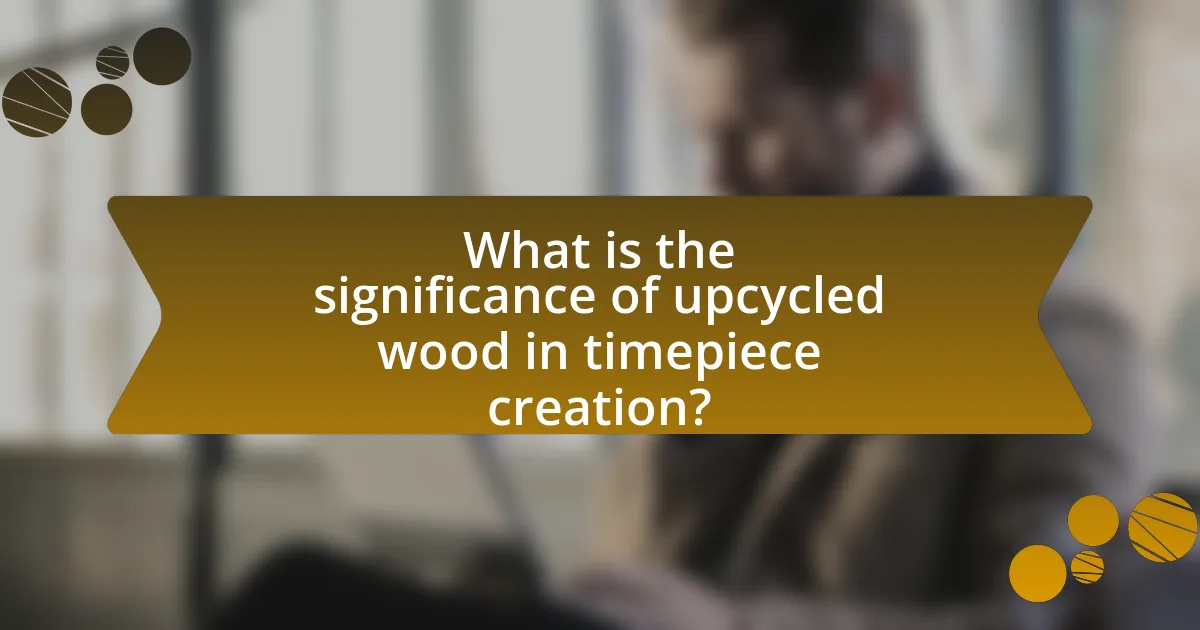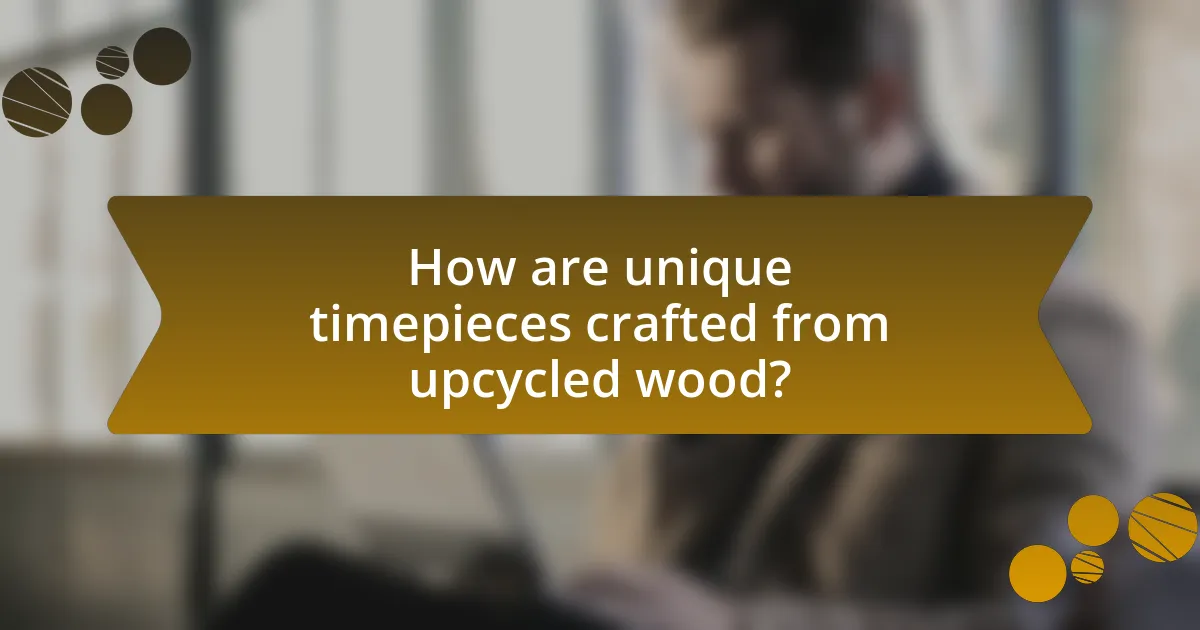The main entity of the article is the rise of upcycled wood in the creation of unique timepieces. The article explores the significance of upcycled wood in promoting sustainability and its aesthetic qualities, driven by consumer demand for eco-friendly products. It discusses the historical factors that contributed to this trend, the environmental benefits of using upcycled materials, and the various types of wood commonly used in watchmaking. Additionally, the article examines the craftsmanship involved in creating these timepieces, the challenges faced in sourcing upcycled wood, and the market trends indicating a growing preference for sustainable timepieces among consumers.

What is the significance of upcycled wood in timepiece creation?
Upcycled wood is significant in timepiece creation because it promotes sustainability while offering unique aesthetic qualities. By repurposing wood from discarded furniture, old buildings, or other sources, artisans create timepieces that not only reduce waste but also feature distinctive grain patterns and colors that cannot be replicated with new materials. This practice aligns with the growing consumer demand for environmentally friendly products, as evidenced by a 2021 survey indicating that 66% of global consumers are willing to pay more for sustainable brands. Thus, upcycled wood enhances both the ecological value and the artistic appeal of timepieces.
How has the trend of upcycling wood emerged in the watch industry?
The trend of upcycling wood in the watch industry has emerged as a response to increasing consumer demand for sustainable and eco-friendly products. This movement is characterized by brands utilizing reclaimed wood from various sources, such as old furniture or construction materials, to create unique timepieces that minimize waste and promote environmental responsibility. For instance, companies like WoodWatch and WeWood have gained popularity by crafting watches from recycled wood, highlighting their commitment to sustainability and appealing to environmentally conscious consumers. This trend not only reflects a shift in consumer values but also aligns with broader efforts in the fashion industry to reduce environmental impact.
What historical factors contributed to the rise of upcycled wood in timepieces?
The rise of upcycled wood in timepieces is primarily attributed to increasing environmental awareness and the demand for sustainable materials. Historically, the late 20th century saw a growing movement towards eco-friendly practices, driven by concerns over deforestation and waste. This shift prompted artisans and manufacturers to seek alternative materials, leading to the innovative use of reclaimed wood from old structures, furniture, and other sources. For instance, the 2000s marked a significant increase in the popularity of upcycled products, with brands like WoodWatch and others emerging to cater to eco-conscious consumers. This trend is supported by statistics indicating that the global market for sustainable goods has been expanding, reflecting a broader societal commitment to sustainability and responsible consumption.
How do consumer preferences influence the use of upcycled wood in watches?
Consumer preferences significantly influence the use of upcycled wood in watches by driving demand for sustainable and eco-friendly products. As consumers increasingly prioritize environmental responsibility, brands respond by incorporating upcycled materials to align with these values. For instance, a survey by Nielsen found that 66% of global consumers are willing to pay more for sustainable brands, indicating a strong market preference for products that utilize recycled or upcycled materials. This trend encourages watch manufacturers to adopt upcycled wood, enhancing their appeal to environmentally conscious buyers while differentiating their products in a competitive market.
What are the environmental benefits of using upcycled wood in timepieces?
Using upcycled wood in timepieces significantly reduces environmental impact by minimizing deforestation and waste. Upcycling repurposes wood that would otherwise contribute to landfill waste, thus conserving natural resources and reducing carbon emissions associated with new wood production. According to the Environmental Protection Agency, wood waste accounts for approximately 10% of all municipal solid waste, highlighting the importance of reusing materials. Additionally, utilizing upcycled wood decreases the demand for new timber, which helps preserve forests and maintain biodiversity.
How does upcycling wood reduce waste and promote sustainability?
Upcycling wood reduces waste and promotes sustainability by repurposing discarded or unused wood materials into new products, thereby diverting them from landfills. This process minimizes the demand for new timber, which helps conserve forests and reduces the carbon footprint associated with logging and manufacturing. According to the Environmental Protection Agency, wood waste constitutes a significant portion of municipal solid waste, and upcycling can effectively reduce this by transforming waste into valuable items, such as unique timepieces. By extending the lifecycle of wood, upcycling not only mitigates waste but also fosters a circular economy, where materials are reused and recycled, contributing to environmental sustainability.
What role does upcycled wood play in reducing the carbon footprint of watchmaking?
Upcycled wood significantly reduces the carbon footprint of watchmaking by repurposing materials that would otherwise contribute to waste and deforestation. This practice minimizes the demand for new timber, thereby conserving forests and the carbon sequestration they provide. For instance, using upcycled wood can lower greenhouse gas emissions associated with logging and processing new wood, as it eliminates the need for these energy-intensive processes. Additionally, studies indicate that upcycling can reduce overall waste by up to 80%, further contributing to a lower carbon footprint in the manufacturing sector, including watchmaking.

What types of upcycled wood are commonly used in timepieces?
Common types of upcycled wood used in timepieces include reclaimed oak, teak, and walnut. Reclaimed oak is often sourced from old barns and buildings, providing durability and a rich history. Teak, known for its water resistance and strength, is frequently salvaged from old boats and furniture. Walnut, valued for its fine grain and color, is typically reclaimed from furniture or flooring. These woods not only enhance the aesthetic appeal of timepieces but also contribute to sustainability by reducing waste and promoting the reuse of materials.
How do different types of upcycled wood affect the aesthetics of watches?
Different types of upcycled wood significantly influence the aesthetics of watches by providing unique textures, colors, and patterns. For instance, reclaimed oak often features a rich grain and warm tones that evoke a rustic charm, while upcycled teak can offer a sleek, modern appearance with its smooth finish and darker hues. The distinct characteristics of each wood type, such as the presence of knots or variations in color, contribute to the individuality of each timepiece, making them visually appealing and one-of-a-kind. Additionally, the sustainable aspect of using upcycled materials adds an eco-friendly narrative that enhances the overall aesthetic value of the watches.
What are the most popular species of wood used in upcycled timepieces?
The most popular species of wood used in upcycled timepieces include oak, walnut, maple, and bamboo. Oak is favored for its durability and rich grain, while walnut is prized for its deep color and unique patterns. Maple offers a lighter hue and fine texture, making it a versatile choice. Bamboo, being a sustainable option, is increasingly used for its eco-friendly properties and lightweight nature. These species are commonly selected for their aesthetic appeal and structural integrity, contributing to the uniqueness and sustainability of upcycled timepieces.
How does the source of upcycled wood impact the quality of the final product?
The source of upcycled wood significantly impacts the quality of the final product by determining its durability, aesthetic appeal, and structural integrity. High-quality sources, such as reclaimed hardwood from old buildings or furniture, often possess superior characteristics like density and grain patterns, which enhance the visual and functional aspects of timepieces. For instance, wood sourced from mature trees typically has tighter growth rings, resulting in a stronger and more stable material. Conversely, wood from less reliable sources may contain defects or inconsistencies that compromise the final product’s longevity and appearance. Studies have shown that upcycled wood from reputable sources can lead to timepieces that not only last longer but also exhibit unique, desirable features that appeal to consumers.
What are the challenges faced in sourcing upcycled wood for timepieces?
Sourcing upcycled wood for timepieces presents several challenges, including availability, quality consistency, and sourcing regulations. The availability of suitable upcycled wood can be limited, as it depends on the supply of discarded or repurposed materials from various sources, such as old furniture or construction sites. Quality consistency is another challenge, as the condition and characteristics of upcycled wood can vary significantly, affecting the final product’s durability and aesthetic appeal. Additionally, sourcing regulations can complicate the process, as certain types of wood may be subject to legal restrictions or require certification to ensure they are sourced sustainably. These factors collectively hinder the efficient procurement of upcycled wood for crafting timepieces.
How do manufacturers ensure the quality and durability of upcycled wood?
Manufacturers ensure the quality and durability of upcycled wood through rigorous inspection, treatment processes, and sourcing standards. They begin by assessing the wood for structural integrity and any signs of damage or decay. Following this, manufacturers often treat the wood with preservatives or finishes that enhance its durability and resistance to environmental factors. Additionally, they source upcycled wood from reputable suppliers who adhere to sustainability and quality standards, ensuring that the material meets specific criteria for use in products like timepieces. This multi-step approach guarantees that the final product not only looks appealing but also stands the test of time.
What regulations or certifications are involved in using upcycled wood?
Using upcycled wood involves compliance with various regulations and certifications, primarily focused on sustainability and safety. The Forest Stewardship Council (FSC) certification ensures that wood products come from responsibly managed forests, while the Sustainable Forestry Initiative (SFI) certification promotes sustainable forest management practices. Additionally, local building codes and regulations may dictate the use of reclaimed materials in construction and manufacturing, ensuring they meet safety standards. These certifications and regulations help verify the environmental integrity and safety of upcycled wood products, supporting responsible sourcing and consumer confidence.

How are unique timepieces crafted from upcycled wood?
Unique timepieces are crafted from upcycled wood through a meticulous process that involves sourcing reclaimed wood, designing the watch components, and assembling them into functional timepieces. The process begins with selecting high-quality upcycled wood, often sourced from old furniture, flooring, or other discarded wooden items, which not only reduces waste but also provides unique grain patterns and colors.
After sourcing, artisans cut and shape the wood into watch cases, dials, and bands, ensuring precision and attention to detail. The wood is then treated to enhance durability and protect against wear. Finally, skilled craftsmen assemble the components, integrating watch movements and ensuring that each piece is both aesthetically pleasing and functional. This method not only promotes sustainability but also results in one-of-a-kind timepieces that reflect the history and character of the upcycled materials used.
What techniques are used to transform upcycled wood into timepieces?
Techniques used to transform upcycled wood into timepieces include milling, shaping, sanding, and finishing. Milling involves cutting the wood into appropriate sizes and shapes, while shaping defines the contours and design of the timepiece. Sanding smooths the surface to prepare it for finishing, which may involve applying oils, stains, or sealants to enhance the wood’s appearance and durability. These processes ensure that the final product is both aesthetically pleasing and functional, allowing for the unique characteristics of the upcycled wood to be showcased in each timepiece.
How does the craftsmanship of upcycled wood watches differ from traditional methods?
The craftsmanship of upcycled wood watches differs from traditional methods primarily in the sourcing and processing of materials. Upcycled wood watches utilize reclaimed wood from various sources, such as old furniture or construction materials, which requires artisans to adapt their techniques to work with irregular shapes and varying wood qualities. In contrast, traditional watchmaking typically involves new, uniform materials that allow for more standardized manufacturing processes. This adaptability in upcycled craftsmanship often results in unique designs and textures, as each piece of reclaimed wood carries its own history and character, making every watch distinct.
What tools and technologies are essential in the creation of these timepieces?
Essential tools and technologies in the creation of timepieces from upcycled wood include precision cutting tools, CNC machines, and finishing equipment. Precision cutting tools, such as saws and chisels, allow artisans to shape the wood accurately, while CNC machines enable automated and intricate designs that enhance the uniqueness of each piece. Finishing equipment, including sanders and polishers, ensures a smooth surface and enhances the aesthetic appeal of the final product. These tools collectively contribute to the craftsmanship and quality of the timepieces, making them distinctive and appealing to consumers.
What design elements make upcycled wood timepieces unique?
Upcycled wood timepieces are unique due to their distinctive grain patterns, color variations, and eco-friendly design. Each piece of wood used in these timepieces carries its own history, resulting in one-of-a-kind aesthetics that cannot be replicated. The natural imperfections and textures of upcycled wood add character, making every watch a unique work of art. Additionally, the sustainable aspect of using reclaimed materials appeals to environmentally conscious consumers, further enhancing the timepieces’ uniqueness.
How do artisans incorporate design trends into upcycled wood watches?
Artisans incorporate design trends into upcycled wood watches by blending contemporary aesthetics with sustainable practices. They often analyze current fashion and design movements, such as minimalism or rustic chic, and apply these styles to the watch designs, ensuring that the final product is both trendy and environmentally friendly. For instance, the use of geometric shapes and natural finishes reflects popular design trends, while the choice of reclaimed wood sources emphasizes sustainability. This approach not only appeals to eco-conscious consumers but also aligns with the growing market demand for unique, handcrafted items that tell a story.
What customization options are available for consumers interested in upcycled wood timepieces?
Consumers interested in upcycled wood timepieces can choose from various customization options, including wood type selection, engraving, strap material, and dial design. Specific wood types, such as reclaimed oak or teak, allow consumers to personalize the aesthetic and sustainability aspects of their timepiece. Engraving options enable the addition of names, dates, or unique designs, enhancing the personal connection to the item. Additionally, consumers can select different strap materials, such as leather or fabric, to match their style preferences. Finally, dial designs can be customized in terms of color and layout, providing a unique look tailored to individual tastes. These options reflect the growing trend of personalization in sustainable fashion, allowing consumers to express their identity while supporting eco-friendly practices.
What are the market trends for upcycled wood timepieces?
The market trends for upcycled wood timepieces indicate a growing consumer preference for sustainable and eco-friendly products. This trend is driven by increasing awareness of environmental issues, with a significant portion of consumers, particularly millennials and Gen Z, prioritizing sustainability in their purchasing decisions. According to a 2021 report by Grand View Research, the global sustainable watch market is projected to grow at a compound annual growth rate (CAGR) of 8.5% from 2021 to 2028, reflecting a broader shift towards eco-conscious consumerism. Additionally, brands that utilize upcycled materials are gaining traction, as they offer unique designs and stories that resonate with environmentally aware consumers.
How has consumer demand shifted towards sustainable timepieces?
Consumer demand has increasingly shifted towards sustainable timepieces as awareness of environmental issues grows. This shift is evidenced by a significant rise in sales of eco-friendly watches, with a report from Grand View Research indicating that the global sustainable watch market is projected to reach $1.5 billion by 2025, reflecting a compound annual growth rate of 8.5%. Additionally, brands utilizing upcycled materials, such as wood, are gaining popularity, as consumers seek products that align with their values of sustainability and ethical sourcing. This trend highlights a broader movement towards responsible consumption in the luxury goods sector.
What are the projected growth rates for the upcycled wood watch market?
The projected growth rate for the upcycled wood watch market is expected to reach a compound annual growth rate (CAGR) of approximately 8% from 2023 to 2030. This growth is driven by increasing consumer demand for sustainable and eco-friendly products, as well as a rising awareness of environmental issues. Market research indicates that the global market for sustainable watches, including those made from upcycled wood, is gaining traction, reflecting a broader trend towards sustainable fashion and lifestyle choices.
What tips should consumers consider when purchasing upcycled wood timepieces?
Consumers should consider the quality and source of the upcycled wood when purchasing upcycled wood timepieces. High-quality wood ensures durability and aesthetic appeal, while sourcing from reputable suppliers guarantees that the wood is genuinely upcycled and environmentally friendly. Additionally, consumers should check for certifications or documentation that verify the upcycling process, as this can indicate the brand’s commitment to sustainability. Understanding the craftsmanship involved in the timepiece’s creation is also essential, as skilled artisans often produce higher-quality products. Finally, consumers should read reviews and seek recommendations to ensure they are investing in a reliable and well-regarded brand.
